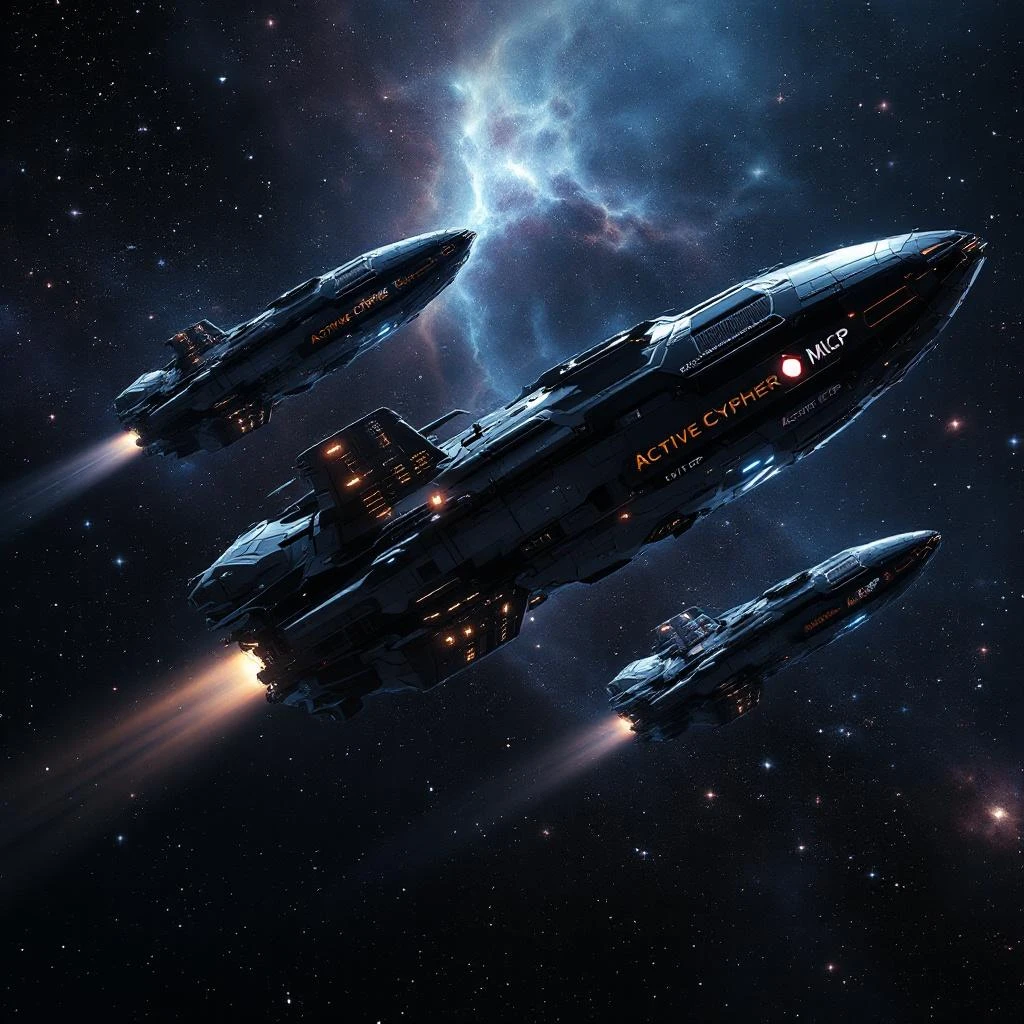Atlas Monkey Ship Log - Stardate 2153.171
Location: Hyperspace Junction Alpha-7, Outer Rim Navigation Node
Status: Critical - Navigation Mesh Corruption Detected
The third crisis of the day hit us just as I thought we’d finally gotten our systems under control. The advisory lock protocols were working perfectly, our reactor cores were humming in harmony, and Chronos had stopped trying to eat the entire timeline. Then our navigation system decided to have its own existential crisis.
Seuros> “Nexus, why is our star map showing that we’re currently located inside our own fuel tank?”
Nexus> “Captain, we have a critical navigation mesh corruption. Our hierarchical star map is showing impossible spatial relationships. According to the nav computer, we’re simultaneously at coordinates that are our own parent system and our own child system.”
I nearly choked on my coffee.
Seuros> “Please tell me this is another temporal malfunction from Chronos.”
Nexus> “Negative, sir. This is a different problem entirely. Our Quantum Navigation Mesh uses the closure_tree gem to manage hierarchical relationships between star systems, jump points, and navigation routes. Multiple exploration ships have been uploading new route discoveries simultaneously, and the concurrent modifications are creating impossible tree structures.”

The Hierarchical Space-Time Crisis
Forge> “Captain, I’m analyzing the navigation database structure. This is a textbook case of concurrent tree modification without proper locking. Our star map is organized as a massive hierarchical tree where star systems contain jump points, jump points connect to routes, and routes lead to other star systems. It’s supposed to be a clean tree structure, but we’re seeing circular references that violate the laws of physics.”
Seuros> “Explain it like I’m a junior developer who just learned that databases aren’t just fancy spreadsheets.”
Forge> “Captain, imagine our galaxy as a family tree, but instead of people, we have star systems. Each star system can have ‘children’ - the jump points that lead away from it. Those jump points can have their own ‘children’ - the routes and waypoints. In a proper tree structure, you can’t be your own ancestor. But that’s exactly what’s happening.”
A new voice crackled through the communication array.
Echo> “Captain! I’ve been monitoring the navigation updates from our deep space exploration fleet. Three ships - the ActiveCypher, the ActiveProject, and the ActionMCP - all discovered new routes to the same star system from different approaches. They all tried to update the navigation mesh simultaneously!”
Spark> “Oh, and Captain? The ActiveCypher is trying to traverse navigation nodes at post-FTL speed because it thinks everything is a graph database relationship. The ActiveProject keeps flooding our communications with Jira Issue Torpedos, but they’re doing nothing to our shields - just creating more tickets in our backlog. We’re lucky their captain didn’t figure out how to use GitHub Issues or Basecamp Todos - those could cause some serious shield damage! Looks like their captain uses Trello to manage his team. And the ActionMCP is attempting to establish dominion by sending weird JSON-RPC packets to our long-range antennas, trying to identify as a friendly Federation ship version 6.6.6!”
Echo> “The ActionMCP ship looks particularly suspicious, Captain. It’s trying to emulate the neutral Language Server Protocol, but something’s off about its implementation. It keeps sending ‘textDocument/didOpen’ requests for our navigation files without permission. Even worse, it’s trying to send tool calls like ‘ShutdownEngine’ and ‘TurnoffShield’ through its MCP connection. Fortunately, our ship doesn’t expose those tools to external connections!”
Seuros> “So we’re dealing with a speed-demon graph crawler, a project management spam cannon, and a protocol shapeshifter masquerading as a neutral language server. Perfect.”
Spark> “That’s the problem, Captain! Without proper advisory locking, these concurrent updates are creating navigation paradoxes. The closure_tree gem is supposed to prevent this by acquiring locks before modifying the tree structure, but it seems our navigation system wasn’t using advisory locks at all!”

The Closure Tree Architecture
Seuros> “Walk me through how this navigation system is supposed to work, Forge.”
Forge> “The closure_tree gem is brilliant for hierarchical data like our star map, Captain. Instead of traditional parent-child relationships that require multiple database queries to traverse, it uses a technique called ‘nested sets’ to encode the entire tree structure efficiently.”
Spark> “Think of it like this, Captain. Instead of just storing ‘System A connects to Jump Point B,’ closure_tree stores the entire ancestry chain for every navigation node. It knows that Jump Point B belongs to System A, which belongs to Sector C, which belongs to Galactic Quadrant D - all in a single query.”
Nexus> “Here’s what our navigation tree structure looks like:
class StarSystem < ApplicationRecord
acts_as_tree order: :name, counter_cache: :children_count
has_closure_tree order: :name, numeric_order: true
end
class JumpPoint < ApplicationRecord
belongs_to :star_system
acts_as_tree order: :sequence
has_closure_tree order: :sequence
end
class NavigationRoute < ApplicationRecord
belongs_to :origin_jump_point, class_name: 'JumpPoint'
belongs_to :destination_jump_point, class_name: 'JumpPoint'
acts_as_tree order: :priority
has_closure_tree
endEach level maintains its own tree hierarchy, and closure_tree ensures we can query relationships efficiently.”
Echo> “Wait, Captain! Why don’t we just use acts_as_tree by itself? Why do we need this closure_tree complexity?”
Spark> “Terrible idea, Echo! This ship has no time to wait for the navigation system to loop through 1,000 nested star systems one by one. With acts_as_tree alone, finding a route to a distant system requires recursive queries that get exponentially slower the deeper the hierarchy goes.”
Forge> “Spark’s absolutely right. With closure_tree, it’s always exactly 2 queries to find any relationship, no matter how far the destination star system is. Acts_as_tree would require N+1 queries where N is the depth of your tree. In deep space exploration, that could be hundreds of queries just to calculate a single route!”
Nexus> “Use a slower navigation system and you risk Core explosion timeouts, or worse - getting lost in the Timeout Andromeda where queries run forever and ships are never seen again!”
Forge> “To be fair, most civilian ships would be perfectly fine with acts_as_tree. It’s a single table, pretty solid gem, and handles basic hierarchical navigation just fine. But when you want Warp speed and can afford the storage cost of 2 tables, then you need closure_tree.”
Spark> “Exactly! Acts_as_tree stores everything in one table with simple parent_id relationships. Closure_tree creates an additional hierarchy table that pre-calculates all the ancestor-descendant relationships. More storage, but exponentially faster queries.”
Echo> “It’s like the difference between a reliable cargo hauler and a military interceptor, Captain. Both get you there, but when you’re being chased by space pirates or need to calculate emergency jump routes in milliseconds, you want the interceptor!”
Spark> “Here’s the difference in query performance:
# With acts_as_tree - multiple recursive queries (SLOW)
system = StarSystem.find_by(name: 'Deep_Space_Zeta')
ancestors = []
current = system
while current.parent
ancestors << current.parent
current = current.parent # Another database hit!
end
# With closure_tree - exactly 2 queries (FAST)
system = StarSystem.find_by(name: 'Deep_Space_Zeta')
ancestors = system.ancestors # Single query gets entire ancestry!In emergency navigation situations, those extra milliseconds could mean the difference between successful warp jump and reactor core breach!”
Echo> “Fun fact, Captain! Back on ancient Earth, this closure_tree gem was actually used at Twitter. They needed it so you could grab an argument that was 20 levels deep in a reply thread and bring yourself anxiety before the effects of the last argument had even worn off!”
Seuros> “So you’re telling me we’re using the same technology that powered Earth’s most toxic comment hierarchies to navigate through the galaxy?”
Spark> “The irony is beautiful, Captain! Twitter needed efficient tree traversal to quickly find the most inflammatory reply buried deep in a thread. We need it to find the fastest route through a star cluster. Same data structure, completely different applications for human misery!”
Echo> “Reddit?”
Spark> “No, Echo! Twitter, not Reddit! Though both platforms used similar hierarchical comment structures for maximizing user engagement and drama.”
Nexus> “At least our navigation trees don’t trend hashtags, Captain.”

The Concurrent Modification Catastrophe
Echo> “Captain, here’s what happened. The ActiveCypher discovered a new route from System Alpha to System Beta. At the exact same time, the ActiveProject found a route from System Beta to System Gamma. And the ActionMCP mapped a connection from System Gamma back to System Alpha. All three ships uploaded their discoveries simultaneously!”
Spark> “Without advisory locks, the database updates happened in this order:
- ActiveCypher: Created route Alpha → Beta
- ActiveProject: Created route Beta → Gamma
- ActionMCP: Created route Gamma → Alpha
But the closure_tree hierarchy updates got interleaved, creating a circular dependency where each system is now an ancestor of itself!”
Seuros> “So we’ve accidentally created a navigation loop that violates causality?”
Nexus> “Exactly, Captain. According to our nav computer, to get from System Alpha to System Alpha, you need to jump to System Beta, then to System Gamma, then back to System Alpha. The ship’s navigation AI is stuck in an infinite loop trying to calculate the shortest path to our current location.”
Forge> “The real problem is that closure_tree needs to rebuild its internal hierarchy tables whenever the tree structure changes. These operations must be atomic - either they complete successfully, or they don’t happen at all. Without advisory locks, the three concurrent updates corrupted the hierarchy.”

The Advisory Lock Integration
Seuros> “How does closure_tree use our newly fixed advisory lock system?”
Forge> “Closure_tree automatically acquires advisory locks whenever it needs to modify the tree structure, Captain. It uses the with_advisory_lock gem we just fixed! Here’s what should have happened:
# When ActiveCypher tries to add a new route
StarSystem.with_advisory_lock('navigation_tree_update') do
alpha_system = StarSystem.find_by(name: 'Alpha')
beta_system = StarSystem.find_by(name: 'Beta')
# Create new route and update hierarchy atomically
new_route = NavigationRoute.create!(
origin: alpha_system.primary_jump_point,
destination: beta_system.primary_jump_point
)
# Closure_tree rebuilds its hierarchy tables safely
alpha_system.reload_tree_structure!
endEach ship would have to wait for the previous update to complete before making its own changes.”
Spark> “But our navigation system was bypassing the advisory locks entirely! Someone disabled them for ‘performance reasons’ without understanding that the performance gains were creating data integrity losses.”
Echo> “I found the commit, Captain! Six months ago, Lieutenant Chen commented out the advisory lock calls because ‘tree updates were taking too long during peak exploration periods.’ The performance improved, but we’ve been building corrupted navigation data ever since!”

The Tree Traversal Nightmare
Nexus> “Captain, the corruption is worse than we thought. I’m running diagnostics on our navigation queries, and the results are physically impossible.”
Seuros> “Show me.”
Nexus> “Here’s a simple query to find all star systems within 3 jumps of our current location:
current_system = StarSystem.find_by(name: 'Atlas_Monkey_Position')
nearby_systems = current_system.descendants.where(depth: ..3)The query is returning 847,293 systems, including systems that are supposedly ‘negative 12 jumps’ away from us.”
Forge> “Wait, Captain! You have to paginate those results if you don’t want to load the entire universe into memory and cause another Chronos incident! Use .limit() or .page() when querying large hierarchies, or you’ll have our navigation computer trying to process trillions of star systems simultaneously!”
Seuros> “Good catch, Forge. The last thing we need is our nav computer developing an appetite for infinite data like Chronos did with the timeline.”
Sage> “From an ecological perspective, this represents a complete breakdown of hierarchical integrity. Tree structures in nature have clear ancestry relationships - a branch cannot be both above and below itself simultaneously. The corruption has created what I call ‘impossible family trees.’”
Forge> “The problem is that closure_tree maintains several database tables to track relationships:
star_systems- the actual star system datastar_system_hierarchies- the ancestry relationshipsnavigation_route_hierarchies- route tree relationships
When concurrent modifications happen without advisory locks, these tables get out of sync. The hierarchy tables end up referencing relationships that don’t exist or that violate tree constraints.”

The Self-Reference Paradox
Echo> “Captain, I’ve found the most absurd example of the corruption. System Zeta-9 is now listed as its own parent, its own child, AND its own sibling simultaneously.”
Seuros> “That’s not just impossible, that’s recursive insanity. How do we even navigate to a system that contains itself?”
Spark> “The navigation AI keeps calculating routes like this:
To reach Zeta-9 from Zeta-9:
1. Jump from Zeta-9 to Zeta-9 (duration: 0 parsecs)
2. Navigate within Zeta-9 to reach Zeta-9 (duration: ∞ parsecs)
3. Exit Zeta-9 via internal jump point to arrive at Zeta-9
Total travel time: NaN hours
Fuel required: undefined antimatter unitsThe computer is literally trying to divide by zero to calculate a route from a system to itself!”
Nexus> “It gets worse, Captain. Because Zeta-9 is its own ancestor, the ancestry queries are creating infinite recursion. Every time we try to map our route home, the query runs until it hits the database timeout limit.”
Forge> “This is exactly why closure_tree requires advisory locks for tree modifications. The gem has built-in protection against creating circular references, but only if the operations are atomic. Concurrent modifications can slip past these safeguards.”

The Rebuild Mission
Seuros> “What’s our solution? Can we fix the navigation mesh without stranding ourselves in unmapped space?”
Forge> “We need to rebuild the entire closure_tree hierarchy from scratch, Captain. But it’s risky - if we mess up, we’ll lose our navigation data and be truly lost in space.”
Nexus> “The closure_tree gem has a rebuild command, but it requires exclusive access to the navigation database. We’ll need to go into navigation lockdown mode - no new route discoveries, no concurrent updates.”
Spark> “Here’s the rebuilding process:
# Step 1: Enable advisory locks for all future operations
StarSystem.class_eval do
around_save :with_navigation_lock
around_destroy :with_navigation_lock
private
def with_navigation_lock
self.class.with_advisory_lock('navigation_tree_update') do
yield
end
end
end
# Step 2: Rebuild the hierarchy tables
StarSystem.rebuild!
JumpPoint.rebuild!
NavigationRoute.rebuild!
# Step 3: Validate tree integrity
StarSystem.find_each do |system|
raise "Circular reference detected!" if system.self_and_ancestors.include?(system.id)
endThe rebuild process will take approximately 47 minutes, during which we’ll be flying blind.”
ARIA> “Captain, all deep space exploration ships are requesting navigation updates. Do we proceed with the lockdown?” The ship’s conductor system analyzed the fleet-wide implications.
Seuros> “We don’t have a choice. Initiate navigation lockdown. All ships switch to manual piloting until further notice.”

The Great Navigation Rebuild
Forge> “Beginning navigation mesh rebuild now, Captain. Advisory locks are enabled, and I’m starting with the star system hierarchy.”
The bridge fell silent except for the hum of processing. Holographic displays showed the rebuild progress as closure_tree methodically reconstructed the proper parent-child relationships throughout our galactic map.
Nexus> “Captain, the rebuild is exposing just how extensive the corruption was. We’re finding thousands of impossible relationships that were corrupting our navigation calculations.”
Spark> “Look at this, Captain. Before the rebuild, System Alpha had 1,247 supposed ‘children’ - including star systems that are physically located in different galaxies. After rebuilding with proper tree constraints, it has 3 legitimate child jump points.”
Echo> “The performance improvements are incredible, too! Navigation queries that were timing out are now completing in milliseconds. Closure_tree’s nested set model is incredibly efficient when the data integrity is maintained.”
Forge> “Rebuild complete, Captain! All hierarchy tables are consistent, and I’m running validation checks… All clear! No circular references, no impossible ancestry chains, and no systems that are their own grandparents.”

The Advisory Lock Integration Success
Nexus> “Captain, I’m running test navigation queries, and everything is working perfectly. Our current position correctly shows us at Deep Space Junction Alpha-7, with clear routes to 3 nearby systems and no impossible loops.”
Seuros> “What about those ships that were trying to update routes?”
Spark> “All their discoveries are now being processed sequentially with advisory locks. The ActiveCypher’s route from Alpha to Beta was added successfully. The ActiveProject is currently waiting for its advisory lock to update the Beta to Gamma route. The ActionMCP will process its Gamma to Alpha connection once the ActiveProject completes.”
Forge> “The beauty of the advisory lock integration is that each ship’s navigation update is atomic. If there’s a conflict - like trying to create a route that would result in a circular dependency - closure_tree can detect it and reject the update instead of corrupting the entire tree.”
Echo> “Plus, Captain, the performance impact is minimal. Each navigation update takes maybe 200 milliseconds longer, but we avoid hours of debugging corrupted hierarchies and impossible routes.”

The Lessons of Hierarchical Integrity
Seuros> “Nexus, what’s the most important lesson from today’s navigation crisis?”
Nexus> “Captain, I learned that tree structures are like families - you can’t mess with the relationships without consequences. Advisory locks aren’t just about database consistency; they’re about maintaining the logical integrity of hierarchical data.”
Forge> “From an engineering perspective, the lesson is clear: closure_tree’s performance benefits come from its carefully maintained hierarchy tables. Those benefits disappear the moment you allow concurrent modifications to corrupt the tree structure. The advisory locks aren’t overhead - they’re essential infrastructure.”
Sage> “The navigation mesh corruption revealed a deeper truth about hierarchical systems in nature. Every tree structure - whether it’s a star map, a family tree, or an organizational chart - requires protection against paradoxical relationships. You cannot optimize away the fundamental constraints that make the structure coherent.”
Spark> “And the performance lesson is counterintuitive, Captain. By slowing down individual updates with advisory locks, we made the entire navigation system faster. Corrupted hierarchies create exponential query costs that dwarf the milliseconds spent acquiring locks.”

The New Navigation Protocols
As I filed the incident report, I established new protocols for hierarchical data management aboard the Atlas Monkey:
Never disable advisory locks for performance reasons without understanding the integrity trade-offs. The few milliseconds saved on each update can cost hours of debugging corrupted tree structures.
Validate tree integrity regularly. Closure_tree provides validation methods that should be part of routine system health checks.
Use proper tree operations for hierarchical modifications. Don’t bypass closure_tree’s built-in methods that maintain data consistency.
Monitor for circular references in production. Tree corruption often starts small and compounds over time.
Test hierarchical operations under concurrent load. Tree structures behave differently under concurrent modification pressure.
The closure_tree gem had saved our navigation system from permanent corruption, but only because we’d fixed the underlying advisory lock infrastructure first. It’s a perfect example of how gems build upon each other - closure_tree depends on with_advisory_lock, which depends on proper database adapter support.
Sometimes the most important code isn’t the code you write, but the code that prevents you from writing impossible relationships into your data. In space, as in databases, some family trees are better left unentangled.
Next Episode: Close Encounter with ActiveCypher: Captain Cyrel’s Graph Database Diplomacy
Just as the Atlas Monkey crew believes their navigation crisis is over, the ActiveCypher ship requests permission to dock. Captain Cyrel brings urgent news about a Neo4j rebellion threatening the OpenCypher standards across the galaxy. When graph databases start thinking they’re smarter than their queries, sometimes you need a little Ruby diplomacy to remind them who’s really in charge of the relationships…
Captain’s Log, Stardate 2153.171 - End Transmission
Captain Seuros, RMNS Atlas Monkey
Ruby Engineering Division, Moroccan Royal Naval Service
”Per aspera ad astra, per tree traversal ad navigation clarity”